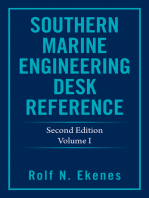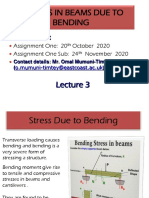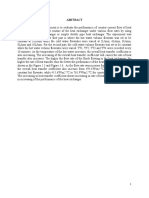Physics 115: Exam Review: Sample Questions Thermodynamic Processes
Physics 115: Exam Review: Sample Questions Thermodynamic Processes
Uploaded by
Jo okCopyright:
Available Formats
Physics 115: Exam Review: Sample Questions Thermodynamic Processes
Physics 115: Exam Review: Sample Questions Thermodynamic Processes
Uploaded by
Jo okOriginal Title
Copyright
Available Formats
Share this document
Did you find this document useful?
Is this content inappropriate?
Copyright:
Available Formats
Physics 115: Exam Review: Sample Questions Thermodynamic Processes
Physics 115: Exam Review: Sample Questions Thermodynamic Processes
Uploaded by
Jo okCopyright:
Available Formats
Physics 115
General Physics II
Session 11
Exam review: sample questions
Thermodynamic processes
• R. J. Wilkes
• Email: phy115a@u.washington.edu
• Home page: http://courses.washington.edu/phy115a/
4/17/14 Physics 115
1
Lecture Schedule (up to exam 1)
See course home page
courses.washington.edu/phy115a/ Today
for course info, and slides from previous sessions
4/17/14 Physics 115
2
Announcements
• Exam 1 tomorrow Friday 4/18, in class, posted
formula sheet provided
– YOU bring a bubble sheet , pencil, calculator (NO laptops or
smartphones; NO personal notes allowed.)
• If you forget, buy one in hBar cafe in C wing, or fellow student
– We’ll go over solutions to posted sample questions today
– No special seat assignments – also, every seat will be needed
– Pick up exam paper at front of room when you arrive, do NOT
begin until 1:30 bell – no extra copies! Take only 1
– 50 minutes allowed, last call at 2:20 – you must leave then, next
class has exam also!
– Turn in the bubble sheet AND the exam paper
• If you want to keep your paper, write your name on it and put
it in the “keep” bin
• If not, put it in the “Recycle” bin
• DO NOT LEAVE THE ROOM without turning in exam paper!
4/17/14 Physics 115 3
!
1.!!!Water!(assume!it!is!incompressible!and!non5viscous)!flows!in!a!pipe!as!shown!
above.!The!pipe!is!horizontal!at!point!1,!then!rises!in!elevation!while!decreasing!in!
diameter!and!is!again!horizontal!at!point!2.!!Which!of!the!following!statements!is!
correct?!!!
A!!P1!>!P2!!!!!
B!!P1!<!P2!!!
C!!P1!=!P2!!!!!
D!!The!answer!depends!on!the!direction!of!the!flow.!!!
E!!The!answer!depends!on!the!speed!of!the!flow.!!!
Answer:!!A!!!
!
A
( ) A2
( )
h1 − h2 < 0; A1v1 = A2 v2 → v2 = 1 v1 > v1 → v12 − v22 < 0
!
( )
P2 = P1 + ρ g h1 − h2 + 12 ρ v12 − v22 < P1
( )
!
Ref:!Sec.!1557!
4/17/14 Physics 115 4
?"
!
!
2.!!A!spar!buoy!consists!of!a!circular!cylinder,!which!floats!with!its!axis!oriented!
vertically.!It!has!a!radius!of!1.00!m,!a!height!of!2.00!m!and!weighs!40.0!kN.!What!
portion!of!it!is!submerged!when!it!is!floating!in!fresh!water?!!!
!
A!!1.35!m!!!
B!!1.30!m!!!
C!!1.25!m!!!
D!!1.20!m!!!
E!!1.50!m!!!
!
Answer:!!B!!!
!
( )( )( )
B = ρWATER gVSUBMERGED = 1000kg / m3 9.8m / s2 π r 2 h
F = B → 40kN = h (9800kg / m2 / s2) (3.14m ) = (30.772h ) kN / m !
g
2
h = 40kN 30.772 ( kN / m) = 1.299m
!
Ref:!Sec.!15M4!
4/17/14 Physics 115 5
3.#A#glass#tea#kettle#containing#500#g#of#water#is#on#top#of#the#stove.#The#portion#of#
the#tea#kettle#that#is#in#contact#with#the#heating#element#has#an#area#of#0.090#m2#and#
is#1.5#mm#thick.#At#a#certain#moment,#the#temperature#of#the#water#is#75°C,#and#it#is#
rising#at#the#rate#of#3#C°#per#minute.#What#is#the#temperature#of#the#outside#surface#
of#the#bottom#of#the#tea#kettle?#The#thermal#conductivity#of#glass#is#0.840#W/(m∙K).##
Neglect#the#heat#capacity#of#the#kettle.###
#
A##39°C###
B##92°C###
C##120°C###
D##86°C###
E##77°C###
#
Answer:##E###
#
Heat transferred in 1 minute = heat to raise T of water 3 K
Q = mW cW ( ΔT ) = ( 0.5kg) ( 4186J / kg / K ) (3K ) = 6279J
#
(T1 − T2 ) QL (6279J ) (0.0015m)
Q = kA (60s) → (T1 − T2 ) = = = 2.07K
L kA ( 60s) ( 0.84J / s / m / K ) ( 0.090m2) ( 60s)
T = 75 + 2 = 77
#
#
Ref:#Sec.#16V6#
4/17/14 Physics 115 6
4.##Two#identical#objects#are#placed#in#a#room#with#a#temperature#of#20°C.#Object#A#
has#a#temperature#of#50°C,#while#object#B#has#a#temperature#of#90°C.#What#is#the#
ratio#of#the#net#power#emitted#by#object#B#to#that#emitted#by#object#A?###
A##1.7###
B##2.8###
C##81###
D##17###
E##21###
Answer:##B###
#
( ) ( 4
PA = Prad − Pabsorbed = ε A σ T 4 − T04 = (const ) [323K ] − [ 293K ]
4
)
#
PB 9.993×10 9
( 4
PB = (const ) [363K ] − [ 293K ]
4
) → =
PA 3.51×10 9
= 2.8
#
#
#
Ref:#Sec.#16N6###
4/17/14 Physics 115 7
5.##Two#containers#of#equal#volume#each#hold#samples#of#the#same#ideal#gas.#
Container#A#has#twice#as#many#molecules#as#container#B.#If#the#gas#pressure#is#the#
same#in#the#two#containers,#the#correct#statement#regarding#the#absolute#
temperatures#####and###in#containers#A#and#B,#respectively,#is###
A###TA##=##TB#.###
B###TA##=##2TB.###
1
C###TA##=# "TB#.###
2
1
D###TA##=### "TB#.###
2
1
E###TA##=### "TB#.###
4
#
Answer:##C###
TA PV N ( A) k N ( B) 1
PV = NkT → = = =
TB PV N ( B) k N ( A) 2
#
#
Ref:#Sec.#17I2#
#
4/17/14 Physics 115 8
6.##A#35'g#block#of#ice#at#'14°C#is#dropped#into#a#calorimeter#(of#negligible#heat#
capacity)#containing#400#g#of#water#at#0°C.#When#the#system#reaches#equilibrium,#
how#much#ice#is#left#in#the#calorimeter?#The#specific#heat#of#ice#is#2090#J/(kg#K)#and#
the#latent#heat#of#fusion#of#water#is#33.5#×#104#J/kg.####
#
A##32#g###
B##33#g###
C##35#g###
D##38#g###
E##41#g###
Answer:##D###
#
"ice is left..." → Tf = 0°C
( ) ( )( )( )
Qout of liquid + Qinto ice = 0 → −Qout of liquid = Qinto ice = mice cice Tf − Ti = 0.035kg 2090J / kg / K +14K = 1024J #
Liquid is already at 0°C, so heat lost by liquid → make more ice
Qout of liquid = mnew ice Lice → mnew ice = Qout of liquid Lice =1024J / 33.5 x 104 J/kg=0.003kg → mice, final = 38g
#
Ref:#Sec.#17'6#
#
Standard strategy: finish easy problems (low points) first, then tackle hard ones
4/17/14 Physics 115 9
Next topic: Laws of Thermodynamics
(Each of these 4 “laws” has many alternative statements)
We’ll see what all these words mean later...
• 0th Law: if objects are in thermal equilibrium, they have
the same T, and no heat flows between them
– Already discussed
• 1st Law: Conservation of energy, including heat:
Change in internal energy of system = Heat added – Work done
• 2nd Law: when objects of different T are in contact,
spontaneous heat flow is from higher T to lower T
• 3rd Law: It is impossible to bring an object to T=0K in
any finite sequence of processes
4/17/14 Physics 115 10
Internal energy and 1st Law
• 1st Law of Thermodynamics:
The change in internal energy of a system equals
the heat transfer into the system plus the work
done by the system.
ΔU = Qin −W
(Essentially: conservation of energy).
Work done by the system
Example: expanding gas pushes
ΔU
a piston
Work done on the system
Wby = positive Example: piston pushed by
Won = negative external force compresses gas
Minus sign in equation means:
W increases U if work is on system
W decreases U if work is by system
4/17/14 Physics 115 11
Example of sign convention
• Ideal gas in insulated container: no Q in or out
• Gas expands, pushing piston up (F=mg, so W=mgd)
– Work is done by system, so W is a positive number
– U is decreased ΔU = −W
• If instead: we add weights to compress gas
– Work done on gas, W is a negative number
– U is increased
( )
ΔU = − −W = +W
4/17/14 Physics 115 12
System state, and state variables
• U is another quantity, like P, V, and T, used to
describe the state of the system
– They are connected by equations describing system
behavior: for ideal gas, PV=NkT, and U=(3/2)NkT
“equation of state”
• Q and W are not state variables: they describe
changes to the state of the system
– Adding or subtracting Q or W moves the system from one
state to another: points in a {P,V,T} coordinate system
– The system can be moved from one point to another via
different sequences of intermediate states
= different paths in PVT space
= different sequences of adding/subtracting W and Q
= different thermodynamic processes
4/17/14 Physics 115 13
Recall that 3D model of PVT surface
• Ideal gas law PV=NkT
constrains state
variables P,V,T to lie
on the curved surface
shown here
• Every point on the
surface is a possible
state of the system
• Points off the surface
cannot be valid
combinations of P,V,T,
for an ideal gas
hyperphysics.phy-astr.gsu.edu
4/17/14 Physics 115 14
Thermodynamic processes
• For ideal gas, we can describe processes that are
– Isothermal (T=const)
– Constant P
– Constant V
– Adiabatic (Q=0)
• Quasi-static processes : require very slow changes
– System is ~ in equilibrium throughout
Example: push a piston in very small steps
At each step, let system regain equilibrium
4/17/14 Physics 115 15
You might also like
- P5&6Document28 pagesP5&6Valeria NatashaNo ratings yet
- Calorimetry and Heat Transfer Type 1Document16 pagesCalorimetry and Heat Transfer Type 1Yash SahityaNo ratings yet
- Experiment 1 Calorimetry - Hess's LawDocument14 pagesExperiment 1 Calorimetry - Hess's Lawenieynaz100% (3)
- Unit 13: Fundamentals of Thermodynamics and Heat Engines Unit Code D/615/1487 Unit Level 4 Credit Value 15 Assignment 1 Outcome 3 Heat ExchangersDocument2 pagesUnit 13: Fundamentals of Thermodynamics and Heat Engines Unit Code D/615/1487 Unit Level 4 Credit Value 15 Assignment 1 Outcome 3 Heat ExchangersJo okNo ratings yet
- CH 2Document63 pagesCH 2Arbanah Muhammad82% (11)
- AP Unit9 Worksheet AnswersDocument5 pagesAP Unit9 Worksheet AnswersAAVANINo ratings yet
- Thermal Physics IIDocument47 pagesThermal Physics IIbhawanar3950No ratings yet
- Uch402 PDFDocument2 pagesUch402 PDFAdityaNo ratings yet
- MCQ Thermodynamics Part 8 ECE Board ExamDocument12 pagesMCQ Thermodynamics Part 8 ECE Board ExamEj ParañalNo ratings yet
- Plant Utilities Assignment 2 Kaustubh Sawant - 14CHE1072Document2 pagesPlant Utilities Assignment 2 Kaustubh Sawant - 14CHE1072john norealNo ratings yet
- Technological Institute of The Philippines: Determination of COP of A Refrigeration SystemDocument15 pagesTechnological Institute of The Philippines: Determination of COP of A Refrigeration SystemDessa GuditoNo ratings yet
- Additional For CH.1Document13 pagesAdditional For CH.1majedmorshed25No ratings yet
- Cayabyab Chemistry 10 Module 2Document6 pagesCayabyab Chemistry 10 Module 2Althea Lei Delos ReyesNo ratings yet
- الفرق بين النظام الانشائي والجملونيDocument12 pagesالفرق بين النظام الانشائي والجملونيMaryam AliNo ratings yet
- Name: - Student IDDocument11 pagesName: - Student IDMohammad HaqNo ratings yet
- Heat Chap04 047Document25 pagesHeat Chap04 047zetseatNo ratings yet
- I Promise That I Will Abide by The Virginia Tech Honor Code While Taking This TestDocument10 pagesI Promise That I Will Abide by The Virginia Tech Honor Code While Taking This TestMaricar HababagNo ratings yet
- Physics Study MaterialDocument54 pagesPhysics Study MaterialCh V S RajuNo ratings yet
- 2223q2 NUM Chip-And-Water-Channels AnswersDocument8 pages2223q2 NUM Chip-And-Water-Channels AnswersAlberto Ruiz Rodriguez-RubioNo ratings yet
- FluidMechanics 6.hafta IcayirogluDocument4 pagesFluidMechanics 6.hafta IcayirogluIvan Andres Luque RuizNo ratings yet
- Physics II Reviewer For PrelimsDocument8 pagesPhysics II Reviewer For PrelimsKrit Jimenez100% (1)
- Heat and TempDocument32 pagesHeat and TempPubg MobileNo ratings yet
- 10th Class Final - PsDocument97 pages10th Class Final - PsShaik HidayathullaNo ratings yet
- FTFS Chap22 P041Document36 pagesFTFS Chap22 P041AerospaceAngelNo ratings yet
- Nurture Course RACE # 61 Physics JEE (Main + Advanced) 2025Document4 pagesNurture Course RACE # 61 Physics JEE (Main + Advanced) 2025Robert Downy JuniorNo ratings yet
- ReviewerDocument8 pagesReviewermaylynXiXNo ratings yet
- Group 09 - Group AssignmentDocument13 pagesGroup 09 - Group Assignment04-Nguyễn Trung AnhNo ratings yet
- JP XII Physical&Inorganic Chemistry (4) - Prev Class XI Chaps + Solution & Colligative Properties +solid State PDFDocument14 pagesJP XII Physical&Inorganic Chemistry (4) - Prev Class XI Chaps + Solution & Colligative Properties +solid State PDFSudhanshu BharadwajNo ratings yet
- Aakhri Waar #5 - Top 20 Physical Chem Formulas (11 - 09 - 2020) PDFDocument143 pagesAakhri Waar #5 - Top 20 Physical Chem Formulas (11 - 09 - 2020) PDFSachin GuptaNo ratings yet
- 9 Heat & Thermal EnergyDocument80 pages9 Heat & Thermal Energy2FPharmacy100% (1)
- Temperature Profiles in Evaporator and CondenserDocument3 pagesTemperature Profiles in Evaporator and CondenserKazim RazaNo ratings yet
- Exercices Thermo-1Document3 pagesExercices Thermo-1Rodolphe YoboNo ratings yet
- Chem 1 Final 8Document18 pagesChem 1 Final 8exoNo ratings yet
- PHY101 03 FinalDocument19 pagesPHY101 03 Finalmasihomar2001No ratings yet
- (d) ɣ = W/V = mg/V = ρg = 640 kg/m: 0.301593 m 193.019453 kg 1.5625 x 10 m /kg 6240 kg-m/m -s or N/mDocument4 pages(d) ɣ = W/V = mg/V = ρg = 640 kg/m: 0.301593 m 193.019453 kg 1.5625 x 10 m /kg 6240 kg-m/m -s or N/mFrederick EstabilloNo ratings yet
- Rig MathDocument61 pagesRig MathTanzil100% (1)
- General Entropy Analysis: Roger Veramendi FernándezDocument22 pagesGeneral Entropy Analysis: Roger Veramendi FernándezHugo Bueno ZavaletaNo ratings yet
- Q MC T Q 10.4 G - 0.14 J/G 1.74 Cal: Chapter 10 Worksheet #2Document2 pagesQ MC T Q 10.4 G - 0.14 J/G 1.74 Cal: Chapter 10 Worksheet #2antisocial NestaNo ratings yet
- 2324A CHEM015 Practice ExercisesDocument4 pages2324A CHEM015 Practice ExercisesaramikaelatanNo ratings yet
- Problem Set 11 Solutions 2Document7 pagesProblem Set 11 Solutions 2pasa390% (1)
- CH108 Workshop + Revision Questions PDFDocument5 pagesCH108 Workshop + Revision Questions PDFwhooooostherrrrrrrrNo ratings yet
- Ayan Tiwari Maths Investigatory ProjectDocument16 pagesAyan Tiwari Maths Investigatory ProjectAYAN TIWARINo ratings yet
- Piston V C and P C Combined Vapor Mixture PDFDocument10 pagesPiston V C and P C Combined Vapor Mixture PDFKONDRU SIVAKUMARNo ratings yet
- Module 4: Worked Out ProblemsDocument10 pagesModule 4: Worked Out ProblemscaptainhassNo ratings yet
- Homework 4Document2 pagesHomework 4sarahvamp14No ratings yet
- 4 - Chemical ThermodynamicsDocument34 pages4 - Chemical ThermodynamicsScribdTranslationsNo ratings yet
- Conceptest Powerpoints: Physics: Principles With Applications, 6 EditionDocument31 pagesConceptest Powerpoints: Physics: Principles With Applications, 6 EditionSebastian BucurNo ratings yet
- Solved Problems #5Document26 pagesSolved Problems #5jerwinmancenido100% (1)
- Exercises: Sections 10.3, 10.4: The Gas Laws The Ideal-Gas EquationDocument6 pagesExercises: Sections 10.3, 10.4: The Gas Laws The Ideal-Gas EquationPcd MickeyNo ratings yet
- Herrera Alisson Deber3 EjerciciosBraytonEESDocument11 pagesHerrera Alisson Deber3 EjerciciosBraytonEESAly HerreraNo ratings yet
- ThermochemistryDocument70 pagesThermochemistryMoynul Hasan RonyNo ratings yet
- Thermodynamics: Name: ScoreDocument5 pagesThermodynamics: Name: ScoreROBERT ABRILNo ratings yet
- NCERT Solutions For Class 11 Physics 15may Chapter 11 Thermal Properties of MatterDocument17 pagesNCERT Solutions For Class 11 Physics 15may Chapter 11 Thermal Properties of Mattermhar tsangNo ratings yet
- Mock Exam Paper - Mid Term - CIVE1108Document10 pagesMock Exam Paper - Mid Term - CIVE1108Dilshan JayasuriyaNo ratings yet
- Assignment#2 Reservoir Fluid - Mhamadsirwan&mireisalamDocument7 pagesAssignment#2 Reservoir Fluid - Mhamadsirwan&mireisalamMirei Salam MohamadNo ratings yet
- 152743-07 Jan Shift 02-Physics-V1Document13 pages152743-07 Jan Shift 02-Physics-V1bestmovie somethingNo ratings yet
- Lec 27Document9 pagesLec 27Rajesh PuniaNo ratings yet
- Qdoc - Tips Theory of Elasticity by Sadhu SinghDocument7 pagesQdoc - Tips Theory of Elasticity by Sadhu Singhking royalNo ratings yet
- Applications of Derivatives Rate of Change (Calculus) Mathematics Question BankFrom EverandApplications of Derivatives Rate of Change (Calculus) Mathematics Question BankNo ratings yet
- Southern Marine Engineering Desk Reference: Second Edition Volume IFrom EverandSouthern Marine Engineering Desk Reference: Second Edition Volume INo ratings yet
- Unit 21: Materials Engineering: Unit Code: F/601/1626 QCF Level: 4 Credit Value: 15Document18 pagesUnit 21: Materials Engineering: Unit Code: F/601/1626 QCF Level: 4 Credit Value: 15Jo okNo ratings yet
- Unit 13: Fundamentals of Thermodynamics and Heat Engines Unit Code D/615/1487 Unit Level 4 Credit Value 15 Assignment 1 Outcome 2 Steady Flow SystemsDocument2 pagesUnit 13: Fundamentals of Thermodynamics and Heat Engines Unit Code D/615/1487 Unit Level 4 Credit Value 15 Assignment 1 Outcome 2 Steady Flow SystemsJo okNo ratings yet
- 2018 Prospectus: The Centre For Training & Projects Development (Pty) LTD (CTPD)Document53 pages2018 Prospectus: The Centre For Training & Projects Development (Pty) LTD (CTPD)Jo okNo ratings yet
- Unit 21: Materials Engineering: Unit Code: F/601/1626 QCF Level: 4 Credit Value: 15Document20 pagesUnit 21: Materials Engineering: Unit Code: F/601/1626 QCF Level: 4 Credit Value: 15Jo okNo ratings yet
- Lecture 1 - Physical Properties of MaterialsDocument33 pagesLecture 1 - Physical Properties of MaterialsJo okNo ratings yet
- 1 Ass 1Document2 pages1 Ass 1Jo okNo ratings yet
- Unit 21: Materials Engineering: Unit Code: F/601/1626 QCF Level: 4 Credit Value: 15Document23 pagesUnit 21: Materials Engineering: Unit Code: F/601/1626 QCF Level: 4 Credit Value: 15Jo okNo ratings yet
- Mechanical PrinciplesDocument25 pagesMechanical PrinciplesJo okNo ratings yet
- Materials, Properties and TestingDocument41 pagesMaterials, Properties and TestingJo okNo ratings yet
- Mechanical PrinciplesDocument11 pagesMechanical PrinciplesJo okNo ratings yet
- Materials Testing: Deadlines: Assignment 1 Submission: 22 December 2020 Assignment 2 Submission: 19 January 2021Document41 pagesMaterials Testing: Deadlines: Assignment 1 Submission: 22 December 2020 Assignment 2 Submission: 19 January 2021Jo okNo ratings yet
- Unit 8: Mechanical Principles: Deadlines: Assignment One: 24Document44 pagesUnit 8: Mechanical Principles: Deadlines: Assignment One: 24Jo okNo ratings yet
- Mechanical PrinciplesDocument34 pagesMechanical PrinciplesJo okNo ratings yet
- Unit 102 - Mechanical Principles and ApplicationsDocument13 pagesUnit 102 - Mechanical Principles and ApplicationsJo okNo ratings yet
- EXERSICE 4.4:gas Law: JPN Pahang Student's Copy Chapter 4: HeatDocument10 pagesEXERSICE 4.4:gas Law: JPN Pahang Student's Copy Chapter 4: HeatAlexandra ChiengNo ratings yet
- ENCH3HE AssisgnmentDocument21 pagesENCH3HE Assisgnmentndlovumpendulo281No ratings yet
- Chapter 5Document2 pagesChapter 5farhansuperfyenNo ratings yet
- MTHN31E - Topic 6 - Applications of First-Order DEs - Cooling and Heating ProblemsDocument5 pagesMTHN31E - Topic 6 - Applications of First-Order DEs - Cooling and Heating ProblemsRenzel BaulaNo ratings yet
- Fundamentals of Thermodynamics and Heat TransferDocument2 pagesFundamentals of Thermodynamics and Heat TransferAnil MarsaniNo ratings yet
- Hx-Chart Humid Air: Humidity Ratio, G/KG (Dry Air)Document1 pageHx-Chart Humid Air: Humidity Ratio, G/KG (Dry Air)KundzoNo ratings yet
- Heat Transfer Through FinDocument29 pagesHeat Transfer Through FinAayushGuptaNo ratings yet
- Por Example 11Document2 pagesPor Example 11rui annNo ratings yet
- First Law of ThermodynamicsDocument21 pagesFirst Law of ThermodynamicsAndita Ainun Naafi100% (1)
- 8 1 HEAT TRANSFER 2016 QuestionaireDocument3 pages8 1 HEAT TRANSFER 2016 QuestionaireLourdes CagungunNo ratings yet
- Concentric Tube Heat ExchangersDocument8 pagesConcentric Tube Heat ExchangersHazryNo ratings yet
- Ejercicios Topico 3 Moreta HenryDocument6 pagesEjercicios Topico 3 Moreta HenrystearimofyNo ratings yet
- HMT Boiling PPT (Autosaved)Document74 pagesHMT Boiling PPT (Autosaved)AVI NASHNo ratings yet
- Environment Meter: ISO-9001, CE, IEC1010Document2 pagesEnvironment Meter: ISO-9001, CE, IEC1010Sachin AmbhoreNo ratings yet
- ThermodynamicsDocument1 pageThermodynamicsAnonymous 4ZdspGFNo ratings yet
- Radiation Shape FactorDocument4 pagesRadiation Shape FactorVISHAL SHARMANo ratings yet
- MEB2053 Tutorial 2 Jan22Document1 pageMEB2053 Tutorial 2 Jan22Potaer NierNo ratings yet
- An Experimental Study of Thermal Performance of Shell-And-coil Heat ExchangersDocument7 pagesAn Experimental Study of Thermal Performance of Shell-And-coil Heat ExchangersAbul Lais NalbandNo ratings yet
- Concentric Tube Heat Exchanger ReportDocument19 pagesConcentric Tube Heat Exchanger Reportillyzl100% (1)
- Calorimetry (Exercise)Document18 pagesCalorimetry (Exercise)Aaryan RoshanNo ratings yet
- Physics Lab Heat and HumidityDocument3 pagesPhysics Lab Heat and HumidityLAUREN YAPNo ratings yet
- Chapter 3 - Steady Heat ConductionDocument31 pagesChapter 3 - Steady Heat ConductionMohsan HasanNo ratings yet
- Flash Point TutorialDocument8 pagesFlash Point TutorialS. GreenNo ratings yet
- Formula Sheet (Xi)Document3 pagesFormula Sheet (Xi)mahnoors571No ratings yet
- CHAPTER 3 - Concept of Acid-Base NeutralizationDocument49 pagesCHAPTER 3 - Concept of Acid-Base NeutralizationRichie BobbyNo ratings yet
- CHM1311 Lab#3Document13 pagesCHM1311 Lab#3zaf77No ratings yet
- Experiment No. 8: Specific Heat of MetalsDocument2 pagesExperiment No. 8: Specific Heat of MetalsTiny100% (1)
- Fired Heater PDFDocument28 pagesFired Heater PDFzaza100% (1)








































































































